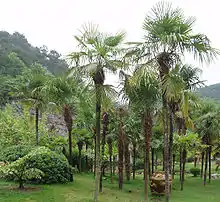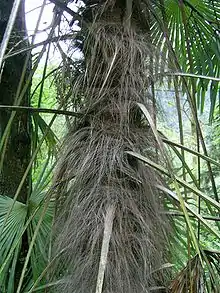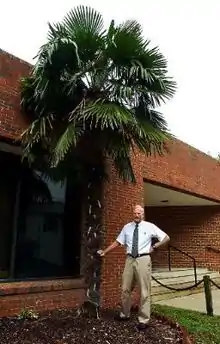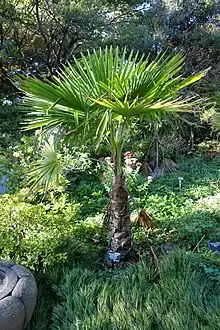Trachycarpus
Trachycarpus is a genus of eleven species of palms native to Asia, from the Himalaya east to eastern China. They are fan palms (subfamily Coryphoideae), with the leaves with a bare petiole terminating in a rounded fan of numerous leaflets. The leaf bases produce persistent fibres that often give the trunk a characteristic hairy appearance. All species are dioecious, with male and female flowers produced on separate plants although female plants will sometimes produce male flowers, allowing occasional self-pollination.
| Trachycarpus | |
|---|---|
 | |
| Trachycarpus fortunei in China | |
| Scientific classification | |
| Kingdom: | Plantae |
| Clade: | Tracheophytes |
| Clade: | Angiosperms |
| Clade: | Monocots |
| Clade: | Commelinids |
| Order: | Arecales |
| Family: | Arecaceae |
| Subfamily: | Coryphoideae |
| Tribe: | Trachycarpeae |
| Genus: | Trachycarpus H.Wendl.[1] |
| Species | |
|
Trachycarpus fortunei | |
Cultivation and uses


The most common species in cultivation is Trachycarpus fortunei (Chusan palm or windmill palm), which is the northernmost cultivated palm species in the world. Cities as far north as London, Dublin, Seattle and Vancouver have long term cultivated palms in several areas. The dwarf form popularly known as T. wagnerianus is unknown in the wild, and is now considered synonymous with T. fortunei [2][3][4] or treated as a cultivar of that species.[5] It resembles T. fortunei closely, differing only in its smaller and stiffer leaves. Hybrids between the two are intermediate in size and fully fertile.
Trachycarpus takil (the Kumaon palm) is similar to T. fortunei and probably even hardier. Other species less common in cultivation are T. geminisectus, T. princeps, T. latisectus, T. martianus, T. nanus and T. oreophilus. Trachycarpus martianus and T. latisectus do not tolerate cold as well as T. fortunei or T. takil. Trachycarpus geminisectus, T. princeps and T. oreophilus are still too rare and small in cultivation to assess their full potential. Two additional species have been described recently: Trachycarpus ukhrulensis from Manipur[6] and T. ravenii from Laos;[7] the former is known from cultivation as Trachycarpus sp. "Manipur" or Trachycarpus sp. "Naga Hills".[4]
The trunk fibres produced by the leaf sheaths of Trachycarpus fortunei are harvested in China and elsewhere to make coarse but very strong rope, brooms and brushes.[2] This use gives rise to the old alternative name "hemp-palm". The fibrous leaf sheaths are also frequently used to clothe the stems of artificial palms.
This genus is very popular among palm enthusiasts for its ability to withstand cold, especially in the form of damp, cool summer weather with relatively mild winter weather. These palms often tolerate snow in their native habitats and are the hardiest trunking palms.
Trachycarpus species are used as food plants by the larvae of some Lepidoptera species including Paysandisia archon (recorded on T. fortunei).
Species
| Image | Scientific name | Height | Distribution |
|---|---|---|---|
 | Trachycarpus fortunei | 10–13 metres (33–43 ft) | China, Japan, Myanmar and India. |
| Trachycarpus geminisectus | 1–2 metres (3.3–6.6 ft) | China, Vietnam | |
| Trachycarpus latisectus | 12 metres (39 ft) | Sikkim | |
 | Trachycarpus martianus | Assam, China South-Central, East Himalaya, Myanmar, Nepal. | |
 | Trachycarpus nanus | 0.9 metres (3.0 ft) | China. |
 | Trachycarpus oreophilus | 9 metres (30 ft) | northwest Thailand, the other in Manipur in northeastern India |
 | Trachycarpus princeps | 9 metres (30 ft) | Yunnan in southern central China |
| Trachycarpus ravenii | 6 metres (20 ft) | Laos | |
 | Trachycarpus takil | 10–15 metres (33–49 ft) | northwestern India, and into adjacent western Nepal |
| Trachycarpus ukhrulensis | 15 metres (49 ft) | Manipur region in Assam, India. | |
References
- H.A. Wendland in J. Gay, Bulletin de la Société Botanique de France 8:429. 1863(?) ("1861")
- Flora of China: Trachycarpus fortunei
- "Trachycarpus fortunei". Germplasm Resources Information Network (GRIN). Agricultural Research Service (ARS), United States Department of Agriculture (USDA). Retrieved 2 January 2018.
- Gibbons, Martyn; Spanner, Toby (2013). "Trachycarpus in the Wild and in Cultivation" (PDF). The Plantsman. New Series. 12: 100–105.
- Riffle, Robert Lee; Craft, Paul; Zona, Scott (2012). The Encyclopedia of Cultivated Palms - Second Edition. Portland, OR: Timber Press. ISBN 9781604692051.
- Lorek, Michael; Pradhan, Keshow Chandra (2006). "A new species of Trachycarpus (Arecaceae), with remarks on its unusual habitat". Botanische Jahrbücher für Systematik, Pflanzengeschichte und Pflanzengeographie. 126 (4): 419–426.
- Averyanov, Leonid V.; Nguyen, Khang Sinh; Nguyen, Tien Hiep; Pham, The Van; Lorphengsy, Shengvilai (2014-10-01). "Trachycarpus ravenii sp. nov. (Arecaceae, Corypheae) from central Laos". Nordic Journal of Botany. 32 (5): 563–568. doi:10.1111/j.1756-1051.2013.00304.x. ISSN 1756-1051.
External links
- Beccari, O. (1931). Asiatic Palms - Corypheae (ed. U. Martelli). Ann. Roy. Bot. Gard. (Calcutta) 13: 1-356.
- Kimnach, M. (1977). The Species of Trachycarpus. Principes 21: 155-160.
- Meerow, A. W. (2005). Betrock's Cold Hardy Palms. Betrock Information Systems, Inc., Hollywood, Florida.
- WCSP, World checklist of Palms: Trachycarpus
- Flora of China: Trachycarpus species list
- Flora of Nepal: Trachycarpus species list
- PACSOA: Trachycarpus
- The Genus Trachycarpus from Palm & Cycad Societies of Florida
- Scanpalm - Trachycarpus cultivation in Scandinavia